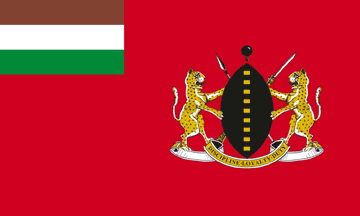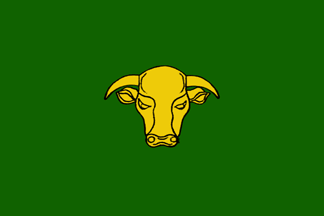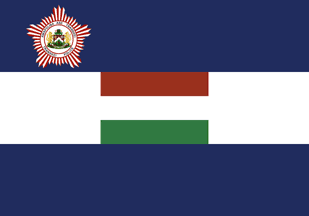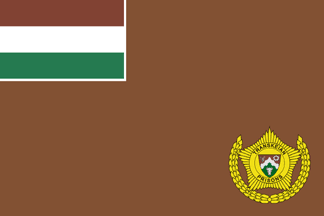 image by Jens Pattke, 09 Jan 2013
image by Jens Pattke, 09 Jan 2013
Last modified: 2013-02-09 by bruce berry
Keywords: south africa | homeland | transkei |
Links: FOTW homepage |
search |
disclaimer and copyright |
write us |
mirrors
![[Transkei]](../images/z/za-trkei.gif) image
by Mark Sensen, 01 Dec 1998
image
by Mark Sensen, 01 Dec 1998
Within the "old" South Africa, 10 homelands were created, four of which
were granted "independence" by South Africa (not recognised by any other
country in the world). These former South African Homelands/bantustans
ceased to exist on 27 April 1994. They have all (including the former so
called independent Homelands) been reincorporated into South Africa.
The flags of the former Homelands are no longer in use (either officially
or unofficially).
Bruce Berry, 25 April 1996
Transkei is quite a large territory in easternmost Cape Province
(today's Eastern Cape), with a larger main part
protruding slightly into Natal and bordering
Lesotho,
Natal and KwaZulu, and two smaller enclaves -- one in Natal, bordering
KwaZulu, and another in the Cape Province, bordering Lesotho and
Orange
Free State.
Antonio Martins, 30 May 1999
The Great Kei River formed the eastern boundary of the Cape Province,
north of which was the traditional territory of the Xhosa tribe. The United
Transkeian Territories General Council was established in 1930 and was
succeeded by a territorial authority in 1956. Transkei was the first homeland
to achieve internal self-government in 1963 and followed by full "independence"
on 26 October 1976.
Mike Oettle, 29 May 1999
The flag was adopted on 20 May 1966 and was officially hoisted for the first time on (South Africa's) Republic Day, 31 may 1966. It was retained unchanged when the Republic of Transkei came into being on 26 October 1976. The red-ochre in the flag is derived from the colour of the soil or "Im-bola" from which traditional huts are built. It is also the colour of traditional blankets, while white stands for peace and the green represents the rolling hills of the countryside, which provides important grazing for cattle which play an important role in Xhosa culture.
The adoption of this flag was not without opposition and The Flag
Bulletin,
XV, 5, September/October 1976, gives an interesting account of the debate.
For the independence ceremonies held on 26 October 1976, special flags
in the national colours were hoisted. These had the Transkei Arms in the
centre of a plain field - in white on green and ochre bunting and in green
on white bunting. These did not replace the flag in any way. Transkei was
re-incorporated into South Africa on 27 April 1994 and is now part of the
Eastern Cape province. Since then the flag is no longer in official use.
Bruce Berry, 01 Dec 1998
I noticed that you wrote "no longer in official use" (while other
homeland flags are simply no more in use). Is it just for a change, or
do you mean that the flag still has some kind of representativity? I had
a feeling that Transkei was more individualized and "real" than most other
homelands (especially after former dictator Kaiser Matanzima, if I remember
his name correctly, turned his back to South African officials after a
disagreement on boundary matters...).
Than Tam Le, 01 Dec 1998
 image by Jens Pattke, 09 Jan 2013
image by Jens Pattke, 09 Jan 2013
The flag of the Transkei Defence Force has a red field, presumably derived from the flag of the South African Army, with the Transkei national flag in the canton, occupying one quarter the length of the field, without any fimbriation. In the lower fly is a black Nguni ox-hide shield, superimposed on a spear and rifle with fixed bayonet in saltire, supported by two leopards standing on a gold ornamental ribbon folded back in white bearing the motto, DISCIPLINE LOYALTY DUTY.
tktdf.gif) image by Jens Pattke, 09 Jan 2013
image by Jens Pattke, 09 Jan 2013
Although the exact date is not known, it is presumed that this flag was adopted
following the introduction of military rule by Major-General Bantu Holomisa on
30 November 1987. Following the reincorporation of Transkei into South Africa on
27 April 1994, this flag is no longer in use.
Bruce Berry, 09 Jan 2013
 image by Jens Pattke, 19 Jan 2013
image by Jens Pattke, 19 Jan 2013
An art-card for the flag of the Transkei Army was prepared by the Heraldic
Section of the South African Defence Force (SADF) on 27 February 1976 and
approved by Brigadier (later Major General) Philip Pretorius, Military Advisor
to the Transkeian Defence Force, on 02 March 1976. It was counter signed by the
State Herald of South Africa. Unlike the flags of the South African Defence
Force and most of the other armed services in the Homelands, this flag does not
contain the national flag of the Homeland in the canton, but has a plain
malachite green field charged in the centre with the emblem of the Transkei
Army, namely a yellow bull's head. It was also used as a car flag (15cm x 23cm)
by the Commander of the Transkei Defence Force. It is
not known how extensively or for how long this flag was used, since in a
subsequent development a separate flag was adopted for the Transkei Defence
Force.
In any event, following the reincorporation of Transkei into South Africa on 27
April 1994, both the Transkei Army and Transkei Defence Force ceased to exist
and were incorporated into the re-named South African National Defence Force and
their flags are no longer used.
Bruce Berry, 19 Jan 2013
 image by Jens Pattke, 19 Jan 2013
image by Jens Pattke, 19 Jan 2013
he flag of the Transkei Police consists of three equal horizontal stripes of dark blue, white and dark blue, with the national flag of Transkei placed centrally on the white stripe. In the canton is the badge of the Transkei Police, namely a rayed five-pointed star shaded brown and white, charged in the centre, on a white roundel, with the coat of arms of Transkei in full colour within a white annulet edged in brown bearing the inscription AMAPOLISA ASE TRANSKEI above, and TRANSKEI POLICE below.
tkpol.gif) image by Jens Pattke, 19 Jan 2013
image by Jens Pattke, 19 Jan 2013
Following the reincorporation of Transkei into South Africa on 27 April 1994,
the Transkei Police was absorbed into the South African
Police Service and this flag is no longer in use.
Bruce Berry, 19 Jan 2013
 image by Jens Pattke, 13 Jan 2013
image by Jens Pattke, 13 Jan 2013
tkpri.gif) image by Jens Pattke, 13 Jan 2013
image by Jens Pattke, 13 Jan 2013
tskei.jpg) scan by
Bruce Berry, 20 Dec 2006
scan by
Bruce Berry, 20 Dec 2006
The Transkei Official Gazette (Vol. 8 No. 2) of January 1971 notified the
adoption of a coat of arms for Transkei that had been registered in terms the
South African Heraldry Act (Act No. 18 of 1962) as approved in Government Notice
1319 of the Government Gazette (No. 2728 of 25 September 1970). In terms
of this notice, a Certificate of Registration (no. 410) was issued on 25
September 1970.
The official description of the Arms is given as:
Arms: Per chevron Ochre and Vert, a chevron dovetailed between in
chief dexter a mealie cob and sinister a cogwheel Argent, and in base a bull's
head caboshed proper.
Crest: On a mount Vert a wicker basket between two aloes proper.
Wreath: Argent and Vert.
Supporters: Two leopards proper.
Motto: IMBUMBA YAMANYAMA (Unity is Strength)
With the re-incorporation of Transkei into South Africa in April 1994, these
Arms are no longer in use.
Bruce Berry, 20 Dec 2006




